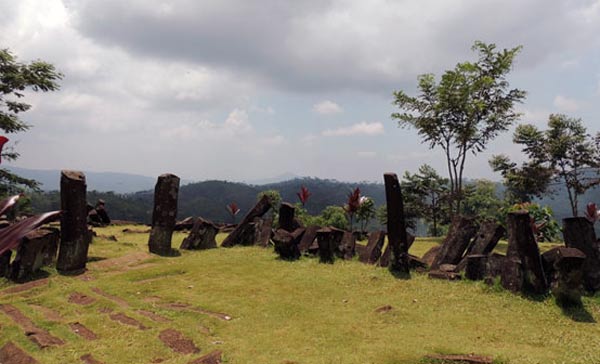The megalithic site of Gunung Padang begins to reveal its secrets
Gunung Padang is a remarkable archaeological region located 120 kilometres south of Jakarta in Indonesia, known for having the largest number of megaliths in the country. It has been the subject of much controversy in recent years as scientific research has suggested that one particular site, consisting of an ancient arrangement of megalithic stones, sits atop a hill that is actually a gigantic, pyramid-shaped tomb, dating back thousands of years. Such conclusions have, unsurprisingly, been met with fierce resistance from the academic and archaeological community. However, according to a report in Jakarta Post, excavation has now revealed an underground room built in prehistoric times, and the team have dated the youngest layer of the site to 5,200 BC.
According to several experts from the Gunung Padang independent and integrated research team (TTRM), the site could potentially be Indonesia’s oldest and most important prehistoric landmark and should be given priority in conservation efforts.

The ancient megalithic site if Gunung Padang, Indonesia. Credit: Alistair Coombs
Last year, Danny Hilman Natawidjaja, a senior geologist at Indonesia’s Centre for Geotechnical Research, conducted extensive surveys of the site, including geo-electric surveys, ground-penetrating radar, core samples, and analysis of stonework. Based on the results, he firmly believes that most of the 100-metre hill, upon which hundreds of megalithic stones are scattered, is actually man-made, built up on several stages over thousands of years by different cultures.
Despite initial opposition to claims that the entire hill was constructed by an ancient civilization, further research has come to confirm this finding and scientists have agreed to categorize the prismatic structure as a stepped pyramid that has an area of 3,094 square meters consisting of five levels. It stands more than 100 meters high and is believed to be the centre of a 25-hectare megalithic site. Dr Natawidjaja realises the challenge he has ahead of him: “It's a strong case but not an easy case. We are up against the world's belief.”

Gunung Padang has the highest concentration of megaliths in the country. Credit: Alistair Coombs.
Researcher Graham Hancock, who has suggested the site could potentially offer proof for a lost advanced civilization of prehistoric antiquity, states on his website that “the archaeological establishment is scrambling to find some reason to reject and pour scorn on the extraordinary consequences of the excavations now taking place at Gunung Padang”.
According to Hancock, archaeologists have been lobbying to get the work stopped and, at one point, succeeded in significantly slowing down the research efforts. However, in August of this year, Dr Natawidjaja and his team were given full permissions to continue with their work, including approval to excavate the concealed chambers, thanks to intervention from the President of Indonesia, who fully supports the investigation.
“Preliminary excavations have produced results that prove beyond doubt that Gunung Padang in indeed a man-made pyramid of great antiquity as Dr Natawidjaja had long ago proposed,” writes Graham Hancock. “It is now evident to all that the site is vastly older than the 2500 years that archaeologists had insisted upon for decades,” he adds.
Featured image: Gunung Padang. Credit: Alistair Coombs




















Comments
Traditional archaeologists are always downplaying any finds that contradict their view of history. They call the archaeologists who find them crackpots etc. and find some mundane explanation for the find. I’m a firm believer in a civilization that came before us but I wish there was a way to date stone. Then the traditionalists could no longer deny the evidence
One can debate the age of the site. But if you look at the layout of the stones and the site as a whole, there is simply no doubt it is of human origin.
Thanks the the fable we're all told about the rise of civilization over the course of the last several thousand years, sites like Gunung Padang are attacked with the venom of medieval inquisitors going after heretics. Alleged scientists can be very religious about their beliefs.
I saw it.
Amazing.
I get that nobody likes to be wrong. I don't, you don't...it's apart of life....but when you find these great and amazing structures that prove to be older than anyone thought, larger, more fantastic, the people working to stop it from being explored and understood are doing more wrong that right. Books are written on paper, not written in stone, so if the books are wrong, we need to change them, update them, and teach everyone from our children to our grandparents as much as we can. It's time.
love, light and blessings
AB
What needs to come next is an exploration of earth catastrophes that ended cultural eras. Much of earth's past is covered up by geological and biological upheavals. The evidence for advanced human culture will help rewrite planetary history and undermine traditional archaeology which is in service to an outmoded paradigm. It is important to break the logjam in our false knowledge of our past.
An important part of the puzzle is the rediscovery of the ancient sky and the planets not in their current orbits. This subject is a big taboo. From Aristotle onwards, a false narrative has been constructed to reassure ourselves that the cosmos is not a threat to us. Even the alternative media is loath to explore this.
From my blog: http://www.planetamnesia.com/alternative-media-and-the-missing-planet-st...
Pages